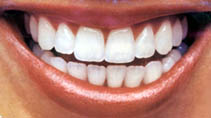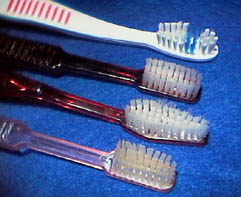|
|
|
![]()
Dental Outlook # 9
© Tomás Seif R. Odontólogo Universidad Central de
Venezuela Master of Science The University of Michigan,
USA e-mail: tseif@cantv.net,
Office numbers: (58-2) 992.02.42, 992.54.31,
992.78.09
Welcome to this section of the Dental Column.
Hopefully all our readers will enjoy it and have the opportunity to learn about the exciting advances and technologies that modern dentistry has to offer.
How to choose a toothbrush
A toothbrush is your number one ally in your fight against tooth decay and gum disease (periodontal disease). Your toothbrush removes food particles and plaque (a thin colorless film of bacteria) that contribute to oral health problems such as tooth decay and gum disease. When plaque is not removed with at least twice daily brushing it eventually hardens into tartar, which can inflame and further irritate the gums. It makes sense to choose and use a good toothbrush.
What to look
for Your dentist or hygienist can recommend a good
toothbrush. Unless your dentist recomends
otherwise, select a brush with soft, polished
bristles, as they are less likely to injure your
gums. Choose a size and shape that feels
comfortable and allows you to reach every tooth. A
child-size toothbrush is easier for children to use
than an adult tbrush, and the variety of colors and
designs provides extra fun for motivation to keep
brushing.
Look for products with the American Dental Associationís Seal of Acceptance. Before the Seal is awarded, a product must undergo stringent testing for safety and effectiveness. Claims made in the labels of products with the ADA seal must be accurate in what they say and what they imply. In other countries look for products manufactured by well known brands with at least the quality seal of that specific country (for example, in Venezuela the NORVEN seal).
All ADA-accepted toothbrushes, manual and powered, are acceptable because they remove plaque above the gumline. The key is that the user must effectively use the brush. A toothbrush used effectively will remove most of the plaque above the gumline. Although there are different techniques for toothbrushing some brushing basics are:
* Place the toothbrush with a 45-degree angle to the gums.
* Gently move the brush back and forth in short, tooth-wide strokes.
* Brush the outer surfaces, the inside surfaces and the chewing surfaces of all teeth.
* clean the inside surfaces of the front teeth, tilt the brush vertically and make several up-and-down strokes .
While toothbrushing removes plaque from the tooth surfaces, it can not do the entire job of removing plaque. Cleaning between the teeth with floss or interdental cleaners removes debris from between the teeth and under the gumline-areas where your toothbrush cannot reach.
Treat yourself to a new toothbrush every three to four months or sooner if the bristles become frayed. A hard, brittle bristle brush can injure your gums. Childrens' brushes often need to be replaced more frequently because they can wear them out sooner.
Electric toothbrushes
Electric toothbrushes can be as effective as manual brushes. The principal value of a powered toothbrush is to perform movement that some people find difficult. For example, people with physical difficulties, such as arthritis, may find an electric toothbrush easier to use. Children may be more inclined to brush regularly because of the novelty of using an electric toothbrush.
Just as with manual toothbrushes, there are a variety of powered brushes with different speeds, different bristle rotations and different head sizes. Choose a brush that feels comfortable in you hand and fits comfortably in your mouth. Products may vary in how they are used particularly in the best angle to hold the brush. Electric toothbrushes have different speeds. If you haven't used one before, and depending upon your state of oral health, your gums may bleed a little initially. Be sure to read the manufacturers directions carefully and to show the brush to your dentist and/or hygienist to make sure that youre using the brush properly.
Adapting your toothbrush
People who have hand, arm or shoulder problems that limit movement may find that by modifying their t oothbrush, they can brush without assistance from other. Here are a few tips:
* Attach the toothbrush handle to the hand with a wide elastic band.
* Enlarge the tootbrushsh handle with a sponge, rubber ball or bicycle handle grip.
* Lengthen the toothbrush handle with a piece of wood or plastic, such as a ruler or wooden tongue blade.
* Bend the toothbrush handle. Running hot water over the handle (not head) of the brush can often do this.
Talk with your dentist if you have questions about which toothbrush would best meet your needs.
I am looking forward to update you with more interesting information about modern dentistry.
Es nuestro interés que la información incluida en esta página sea de su ayuda. Si tiene alguna pregunta puede envíarnos un correo electrónico, o si desea que incluyamos algún tópico en particular en esta sección puede contáctarnos a través de nuestro libro de visitas.

